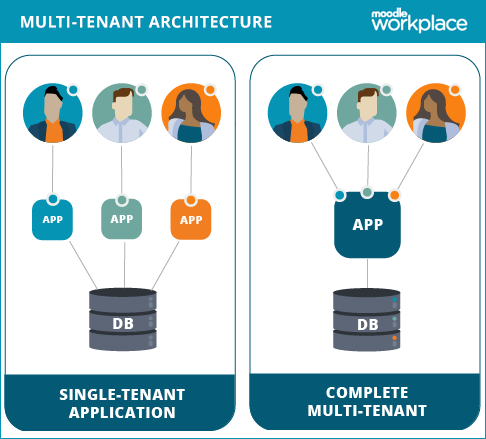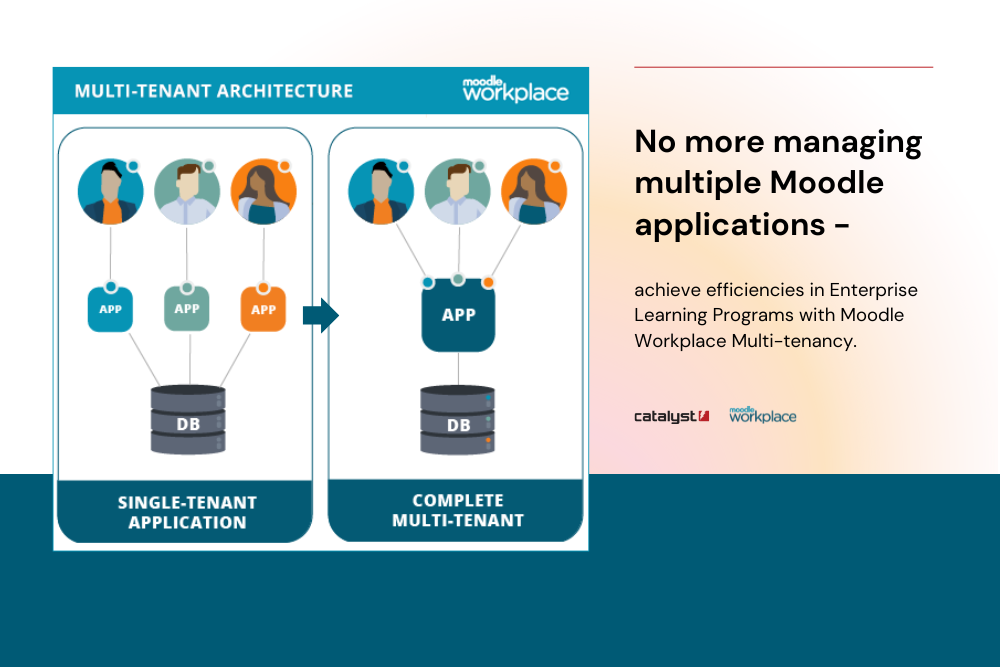Why Moodle Workplace Multi-tenancy is a perfect fit for large and growing organisations.
In this blog, we provide you with an overview of some of the key benefits of Moodle Workplace Multi-tenancy, and a free downloadable checklist for implementing and making the most of this feature.
Apart from the regulatory compliance training, there are two key reasons why organisations invest in corporate learning programs:
- Learning and development is directly linked to employee satisfaction and retention.
- Rapidly evolving business environments require constant up-skilling and re-skilling of workforce. According to research by the World Economic Forum, nearly half of the workforce is projected to require re-skilling by 2023.
Large and growing organisations are under increasing pressure to implement effective corporate programs but what makes workplace learning effective?
Some aspects of an effective corporate Learning and Development Program include:
- Strategic alignment between L&D and Business Goals
- Tailored, engaging content – personalized to different learners’ / departments’ needs
- Ease of management (efficiencies) – having the right tools, systems and processes in place to provide friction-less user experience for all – learners, administrators and managers; as well as customized control and reporting to monitor compliance obligations
- Cost effectiveness
Personalized learning & implications to running multiple LMS Sites.
Addressing diverse learning needs, offering personalized learning pathways and flexibility in how learners access their courses, while maintaining control and consistency across the organisation can be a real challenge.
Very often, organisations have to run multiple LMS sites to deal with requirements of different teams, resulting in ever-growing administrative tasks burden, escalating costs and bad user experience.
In addition, managing multiple LMS sites makes monitoring, reporting and making sense of data difficult.
Last, but not least, maintaining overall system integrity across multiple LMS can be challenging.
What is Multi-tenant Architecture?
“Multi-tenancy is a reference to the mode of operation of software where multiple independent instances of one or multiple applications operate in a shared environment. The instances (tenants) are logically isolated, but physically integrated.” – Source

Understanding Multi-tenancy in Moodle Workplace.
Moodle Workplace Multi-tenancy feature is something we and our clients are very excited about. If you have to manage multiple learner groups / departments with very different needs, while trying to maintain efficiency and security, Moodle Workplace Multi-tenancy will solve your problems by providing you with the following:
Tailored Learning Environments
Takes customization to the next level, allowing you to create distinct learning environments, or “tenants,” for each department or business unit. Each tenant can be fully personalized with its own look and feel, branding, user roles, and permissions, ensuring that every team receives training that’s not just relevant, but perfectly suited to their specific goals and challenges.
Having isolated environments also means that users, courses and data specific to one tenant is not visible to others, ensuring privacy and data security.
Centralized Administration & Efficient Learning Management
Despite having separate environments, Moodle Workplace Multi-tenancy allows for centralized administration. This means that while each tenant operates independently, overall management and oversight remain unified.
Administrators can efficiently manage users, courses, and reporting across all tenants from a single interface. Maintaining control / consistencies while still allowing for tenant specific configurations becomes easy.
As your organisation will grow, you will be able to add new tenants, without the need for separate LMS installations, achieving significant efficiencies in admin and management time.
Shared resources
One of the standout benefits of Multi-tenancy is the ability to share content across different tenants. While you’re able to enjoy the isolation and flexibility in learning environments, you can keep training materials, courses and resources centrally, and make them available to all or selected tenants. This promotes consistency in training quality and ensures that all parts of the organization have access to the best resources which are centrally maintained and updated as required.
Enhanced User Experience
All of the above-mentioned benefits improve user experience for all – managers, administrators and learners. Seeing information that’s only relevant to one learner group makes learning experience less overwhelming and more engaging. Support can be customized to each tenant too, ensuring assistance provided is relevant to specific contexts and needs.
Self-enrolment
Self-enrolment feature in Moodle Workplace empowers employees to take ownership of their learning paths, leading to increased motivation, while reducing administrative burdens. This feature also provides leaders with valuable insights into learning trends (what courses your employees are interested in for example), helping them refine training programs and align across business objectives; ultimately supporting a culture of continuous professional development and improving employee engagement.
Cost-effectiveness & Scalability
Moodle Workplace’s Multi-tenancy feature significantly enhances ROI making the expansion of your training programs more cost-effective. By allowing multiple tenants within a single platform, you eliminate the need for duplicating efforts and resources, resulting in substantial savings in both time (especially when it comes to administration tasks) and money.
Monitoring, reporting and compliance obligations
With Moodle Workplace Multi-tenancy, you are able to to generate reports specific to each learning environment / tenant – having insights into their performance, engagement and learning outcomes without diluting the irrelevant data i.e. data that belongs to other learner groups.
You can of course get a holistic view on your L&D efforts as well, by aggregating the reports across all tenants.
Enhanced security and compliance
Having each tenant operate in a segregated environment enhances security and compliance. Sensitive data remains within the relevant tenant, reducing the risk of cross-departmental data breaches. Compliance with industry-specific regulations is easier to manage when each business unit’s data and training are handled separately.
Getting started with Multi-tenancy
Implementing Moodle Workplace is easier than you think and the benefits will outweigh the costs. To help you get started, we’ve created a comprehensive toolkit to guide you through the process:
As a multi-award winning Premium Moodle Partner, Catalyst IT Group is are one of the biggest contributors to the Moodle Project. We specialize in large, complex Moodle sites and offer fully managed IT services and 24/7 support for our clients.



